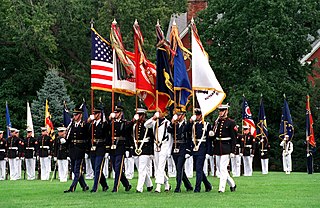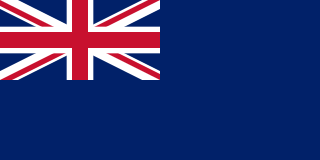Related Research Articles

In military organizations, a colour guard is a detachment of soldiers assigned to the protection of regimental colours and the national flag. This duty is highly prestigious, and the military colour is generally carried by a young officer (ensign), while experienced non-commissioned officers are assigned to the protection of the national flag. These non-commissioned officers, accompanied in several countries by warrant officers, can be ceremonially armed with either sabres or rifles to protect the colour. Colour guards are generally dismounted, but there are also mounted colour guard formations as well.

The Union Jack, or Union Flag, is the de facto national flag of the United Kingdom. Although no law has been passed making the Union Flag the official national flag of the United Kingdom, it has effectively become such through precedent. It is the national flag of all British overseas territories, being localities within the British state. The Union Flag was also used as the official flag of several British colonies and dominions before they adopted their own national flags. The flag continues to have official status in Canada, by parliamentary resolution, where it is known as the Royal Union Flag.

This is a collection of lists of flags, including the flags of states or territories, groups or movements and individual people. There are also lists of historical flags and military flag galleries. Many of the flag images are on Wikimedia Commons.

The ensign is a maritime flag that is used for the national identification of a ship. The ensign is the largest flag, generally flown at the stern (rear) of the ship while in port. In ports, depending on the ship's origin, it is sometimes identical with a jack on the bow of the ship. Jacks are more common on warships than on merchant ships.
Second lieutenant is a junior commissioned officer military rank in many armed forces.

In British maritime law and custom, an ensign is the identifying flag flown to designate a British ship, either military or civilian. Such flags display the United Kingdom Union Flag in the canton, with either a red, white or blue field, dependent on whether the vessel is civilian, naval, or in a special category. These are known as the red, white, and blue ensigns respectively.

The several branches of the United States Armed Forces are represented by flags. Within the U.S. military, various flags fly on various occasions, and on various ships, bases, camps, and military academies.

The Blue Ensign is a flag, one of several British ensigns, used by certain organisations or territories associated or formerly associated with the United Kingdom. It is used either plain or defaced with a badge or other emblem.

The White Ensign, at one time called the St George's Ensign because of the simultaneous existence of a crossless version of the flag, is an ensign worn on British Royal Navy ships and shore establishments. It consists of a red St George's Cross on a white field, identical to the flag of England except with the Union Flag in the upper canton.
Ensign is a junior rank of a commissioned officer in the armed forces of some countries, normally in the infantry or navy. As the junior officer in an infantry regiment was traditionally the carrier of the ensign flag, the rank acquired the name. This rank has generally been replaced in army ranks by second lieutenant. Ensigns were generally the lowest-ranking commissioned officer, except where the rank of subaltern existed. In contrast, the Arab rank of ensign, لواء, liwa', derives from the command of units with an ensign, not the carrier of such a unit's ensign, and is today the equivalent of a major general.

In military organizations, the practice of carrying colours, standards, flags, or guidons, both to act as a rallying point for troops and to mark the location of the commander, is thought to have originated in Ancient Egypt some 5,000 years ago. The Roman Empire also made battle standards, reading SPQR a part of their vast armies. It was formalized in the armies of Europe in the High Middle Ages, with standards being emblazoned with the commander's coat of arms.

A war flag, also known as a military flag, battle flag, or standard, is a variant of a national flag for use by a country's military forces when on land. The nautical equivalent is a naval ensign. Under the strictest sense of the term, few countries today currently have proper war flags, most preferring to use instead their state flag or standard national flag for this purpose.

A roundel is a circular disc used as a symbol. The term is used in heraldry, but also commonly used to refer to a type of national insignia used on military aircraft, generally circular in shape and usually comprising concentric rings of different colours. Other symbols also often use round shapes.
A flag officer is a commissioned officer in a nation's armed forces senior enough to be entitled to fly a flag to mark the position from which the officer exercises command.

The Royal Australian Air Force Ensign is used by the Royal Australian Air Force and the Australian Air Force Cadets in Australia and overseas. It is based on the Australian national flag, with the field changed to Air Force blue, and the southern cross tilted clockwise to make room for the RAAF roundel inserted in the lower fly quarter. The roundel is a red leaping kangaroo on white within a dark blue ring. The ensign was proclaimed as a Flag of Australia under section 5 of the Flags Act on 6 May 1982.

The Royal Air Force Ensign is the official flag which is used to represent the Royal Air Force. The ensign has a field of air force blue with the United Kingdom's flag in the canton and the Royal Air Force's roundel in the middle of the fly.

The flag of Australia, also known as the Australian Blue Ensign, is based on the British Blue Ensign—a blue field with the Union Jack in the upper hoist quarter—augmented with a large white seven-pointed star and a representation of the Southern Cross constellation, made up of five white stars. Australia also has a number of other official flags representing its people and core functions of government.

The Star of India refers to a group of flags used during the period of the British Raj in the Indian subcontinent. India had a range of flags for different purposes during its existence. The Princely states had their own flags which were to be flown alongside the British flag as a symbol of suzerainty. The official state flag for use on land was the Union Flag of the United Kingdom and it was this flag that was lowered on Independence Day in 1947. The flag of the governor-general of India was defaced with the Star of India. The civil ensign and naval ensign were the Red Ensign or Blue Ensign, respectively, defaced with the Star of India emblem.
References
- ↑ Znamierowski. "Air force flags". The World Encyclopedia of Flags. p. 85.
- ↑ Crampton, William G (1989). The Complete Guide to Flags. Gallery Books. p. 133. ISBN 9780831716059.